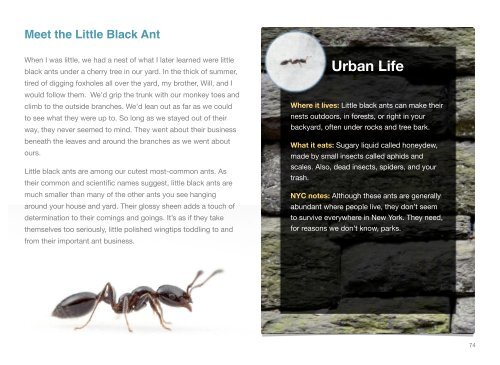th15IH
th15IH
th15IH
Create successful ePaper yourself
Turn your PDF publications into a flip-book with our unique Google optimized e-Paper software.
Meet the Little Black Ant<br />
When I was little, we had a nest of what I later learned were little<br />
black ants under a cherry tree in our yard. In the thick of summer,<br />
tired of digging foxholes all over the yard, my brother, Will, and I<br />
would follow them. We’d grip the trunk with our monkey toes and<br />
climb to the outside branches. We’d lean out as far as we could<br />
to see what they were up to. So long as we stayed out of their<br />
way, they never seemed to mind. They went about their business<br />
beneath the leaves and around the branches as we went about<br />
ours.<br />
Little black ants are among our cutest most-common ants. As<br />
their common and scientific names suggest, little black ants are<br />
much smaller than many of the other ants you see hanging<br />
around your house and yard. Their glossy sheen adds a touch of<br />
determination to their comings and goings. It’s as if they take<br />
themselves too seriously, little polished wingtips toddling to and<br />
from their important ant business.<br />
Urban Life<br />
Where it lives: Little black ants can make their<br />
nests outdoors, in forests, or right in your<br />
backyard, often under rocks and tree bark.<br />
What it eats: Sugary liquid called honeydew,<br />
made by small insects called aphids and<br />
scales. Also, dead insects, spiders, and your<br />
trash.<br />
NYC notes: Although these ants are generally<br />
abundant where people live, they don’t seem<br />
to survive everywhere in New York. They need,<br />
for reasons we don’t know, parks.<br />
74


